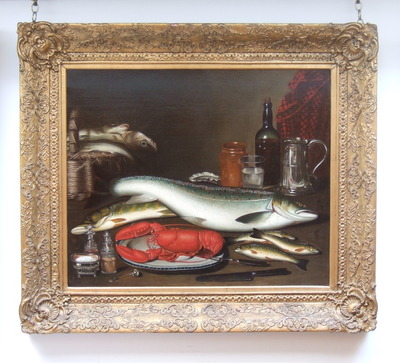painting
- View other items in:
- antique art
- paintings
charles daggett gallery
Enquire about this antique
Charles Daggett Gallery has 57 antiques for sale.
click here to see them all
A Still Life of Fish and Lobster
By Alexander Dalziel, Snr (1781-1832)
Oil on canvas, size 25” x 30”
Signed and dated 1827
Also inscribed verso, with ‘Newcastle’ added.
Alexander Dalziel was born in Wooler, Northumberland, a prosperous town about 47 miles North West from Newcastle on the road to Coldstream, with a population in 1821 of 1,830. When he was 23, Dalziel married Elizabeth Hills and they had a large family of eight boys and four girls. Dalziel was a gardener and seedsman, or horticulturalist, and also held a commission in the local Militia Regiment. In the course of his trade, Dalziel probably had reason to visit all the large houses in the district , where he may have had the opportunity to look at the collections of pictures. This would seem to be the only explanation for his ability to paint pictures such as this, which is directly inspired by the famous still lifes of the Seventeenth Century Dutch School. A contemporary author wrote , ‘considering he is altogether self taught, has lived in a part of the county remote from artists or their works, and under the pressure of a large family, his paintings of fish and some other objects of still life are really surprising productions.’
Antiques.co.uk Ref: M39JM6JW
Charles Daggett Gallery
Charles Daggett Gallery Dealers in British Pictures (c.1700-1820) and Antique picture frames. Also restorers of pictures and antique frames, mount makers and manufacturers of gilded reproduction frames. The frames illustrated here are only a small representative selection from our stock of approx. 500 Antique frames and second hand frames. Please contact us for further information, or send the size of your picture and we will search our stock and email photos. Prices include VAT (currently 15%), which may be refunded in the case of export outside the E.U.
Contact details
225 Kensington Church Street
London
Central London
W8 7LX
UNITED KINGDOM
T: 02072292248
E: charles@daggettgalleries.com
charles daggett gallery
Charles Daggett Gallery has 57 antiques for sale.
click here to see them all














